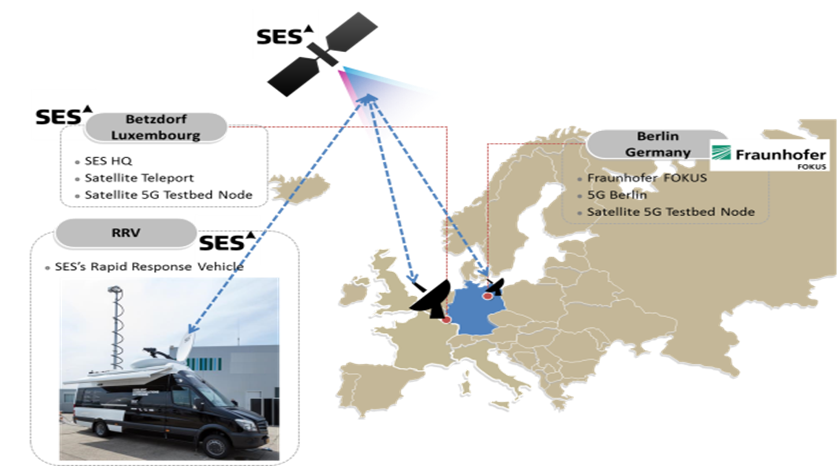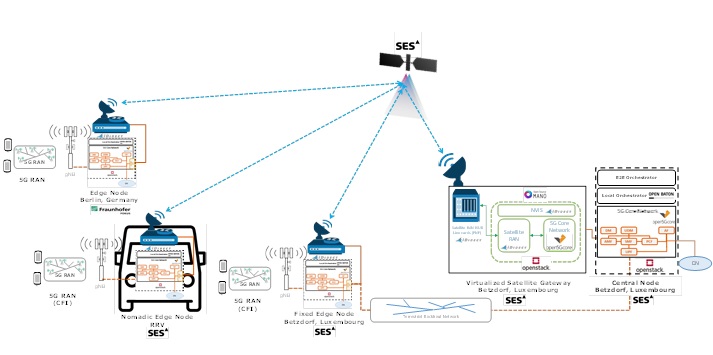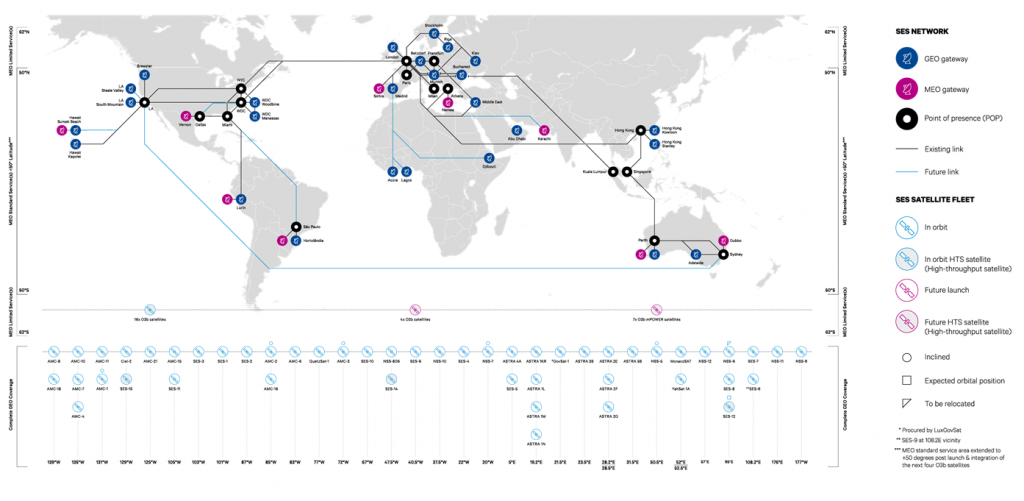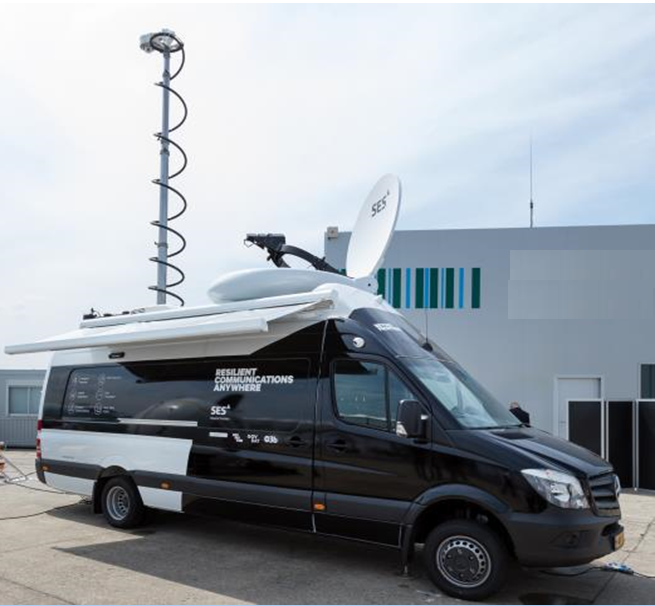Contact: luxemburg-facility@5g-vinni.eu
The 5G-VINNI moving experimentation facility site concentrates on the research, development, experimentation, validation and demonstration of customized solutions for satellite integration into 5G, with focus on satellite backhauling solutions.
The 5G-VINNI moving experimentation facility site is enabled by the satellite connected vehicle (or else referred to as “Rapid Response Vehicle” – RRV) which is owned by SES and provides satellite backhaul capabilities. RRV is a multi-purpose communications platform mainly for governmental and PPDR use cases, its architecture is modular and supports evolution, it is highly resilient due to its multi-band capability, it is designed to be easily configured, even remotely, quickly deployed and operational in minutes, and built for client showcases and demonstrations. As such, the SES’ owned RRV will enable the 5G-VINNI moving experimentation facility site to become a rolling lab for 5G mission specific solutions.
The 5G-VINNI moving experimentation facility site is interconnected through SES’ satellite fleet with the 5G-VINNI Berlin experimentation facility site and the SES’ teleport site located in Betzdorf, Luxembourg. Building upon synergies with the ESA ARTES project “SATis5” (Demonstrator for Satellite-Terrestrial Integration in the 5G Context), the 5G-VINNI moving experimentation facility site hosts satellite 5G testbed nodes which provide SDN/NFV/MEC capabilities and enable eMBB and mMTC use cases over satellite.

Figure1: Satellite Interconnection between 5G-VINNI Moving Experimentation Facility Site and 5G-VINNI Berlin Experimentation Facility Site
Summary of capabilities
- Nomadic and Fixed Edge Nodes
- GEO/MEO Satellite Backhauling
- Satellite Integration into 3GPP Core Network Architechture
- 5G Core (Open5GCore)
- NFVI (OpenStack)
- MANO (OSM)
- Edge Computing (Edge-Central Network Split)
- Network Slicing (eMBB, mMTC)
- Satellite Interconnection with Berlin Experimentation Facility Site
Verticals supported by the 5G-VINNI moving experimentation facility site include mainly PPDR, but also Media and Transportation.
Satellite use cases for both eMBB and mMTC usage scenarios will be supported by the 5G-VINNI moving experimentation facility site:
- Public Safety Communications
- Emergency Response
- Disaster Relief
- Telemedicine
- Video Contributions
- Connected Vehicles
Relevant key KPIs to be challenged and validated include:
- Ubiquity
- Reliability
- Throughput
The architecture of the 5G-VINNI experimentation facility site is illustrated in Figure 2 below. The main components include:
- Space Segment;
- Virtualized Satellite Gateway with integrated 3GPP Core Network;
- 5G Central Node;
- Nomadic and Fixed 5G Edge Nodes.

Figure 2: 5G-VINNI Moving Experimentation Facility Site Architecture
Space Segment: The space segment of the 5G-VINNI experimentation facility site corresponds to the SES’ multi-orbit and multi-band transparent (bent-pipe) satellite fleet which provides seamless connectivity between the remote terminals and the hub platform located at the SES’ teleport site in Betzdorf, Luxembourg (see Figure 3).

Figure 3: SES’ Network Map
Virtualized Satellite Gateway: The satellite ground segment corresponds to the iDirect Velocity™ Intelligent Gateway (IGW) system residing at the SES’ teleport site in Betzdorf, Luxembourg. The system introduces a standard 3GPP Core Network (SatCore) to the satellite hub platform where functions of the existing satellite network are offloaded allowing the SatCore to operate and manage the satellite network like a typical terrestrial 3GPP network. In particular, the Fraunhofer FOKUS’ 5G Core Network solution Open5GCore is introduced as the SatCore. The existing satellite network is modified to behave like a standard RAN, referred to as Satellite RAN (SatRAN), node to the SatCore. With the integration of the Open5GCore into the SatCore, the SatRAN presents itself as a standard gNB 5G RAN and the remote satellite terminal presents itself as a standard 5G UE to the network. Adopting the 3GPP architecture enables support for 3GPP services, such as roaming, authentication, billing and policy and charging. This also enables the management of the satellite network by the MNO in a seamless way, as a common network management framework can be used. Also, the SatCore can be operated by the MNO or by SES, depending on the business model, and there may even be separate 3GPP core networks for the MNO’s cellular and SES’ satellite networks. The satellite network functions are virtualised by transferring their execution environment from a dedicated server to a VM using the OpenStack Pike VIM. Satellite VNFs include the SatRAN network function, the satellite 3GPP Core Network function (SatCore), the satellite NMS as well as additional auxiliary VNFs deployed on the same system using the OpenStack VIM. In terms of MANO, the satellite ground segment system is integrated with the OSM.
5G Central and Edge Nodes: The 5G-VINNI experimentation facility site implements an edge-central network split, which is expressed as the split of the 5G system between edge and central network. In this context, in order to assure the connectivity to the 5G network though the different backhauls, the 5G Core Network is deployed with a functional split between the edge and the central network. The 5G Central Node of the 5G-VINNI moving experimentation facility site is located at the SES’ teleport site in Betzdorf, Luxembourg and includes the Fraunhofer FOKUS’ 5G Core Network solution Open5GCore for the management of the terrestrial 5G RAN, the Local Orchestrator and the E2E Orchestrator. As illustrated in Figure 2, there are three 5G Edge Nodes: a Nomadic 5G Edge Node on-board the SES’ RRV (satellite connected vehicle), a Fixed 5G Edge Node residing at the SES’ teleport site in Betzdorf, Luxembourg, and a 5G Edge Node residing in the 5G-VINNI Berlin experimentation facility site.
The SES’ owned RRV will enable the 5G-VINNI moving experimentation facility site to become a rolling lab for 5G mission specific solutions. The RRV can be rapidly deployed and provide satellite backhaul capabilities (either as a primary or backup connectivity) enabling local terrestrial communications. The RRV is already equipped with a variety of capabilities, including Wi-Fi technology, licensed VHF radios for push to talk (“PTT”) applications as well as with high-definition video surveillance cameras and autonomous power supply. Other local terrestrial communications systems which can be integrated with the RRV infrastructure correspond to Customer Furnished Items (CFIs) and include systems such as e.g., 4G/5G RAN, TETRA, and M2M/IoT.

Figure 4: SES’s Rapid Response Vehicle (RRV)
References
- SES Rapid Response Vehicle (RRV): https://www.ses.com/rapid-response-vehicle-rrv
- ESA ARTES project “SATis5” (Demonstrator for Satellite-Terrestrial Integration in the 5G Context): https://satis5.eurescom.eu/
- Politis, K. Liolis, M. Corici, E. Troudt, Z. Szabó J. Cahill, “Design of Moving Experimentation Facility to Showcase Satellite Integration into 5G”, in Proc. 28th European Conference on Networks and Communications (EuCNC 2019), Valencia, Spain, June 2019. (https://ieeexplore.ieee.org/document/8801980/ and Open Access through: https://zenodo.org/record/3405974#.XbCX2ymP6dI)


